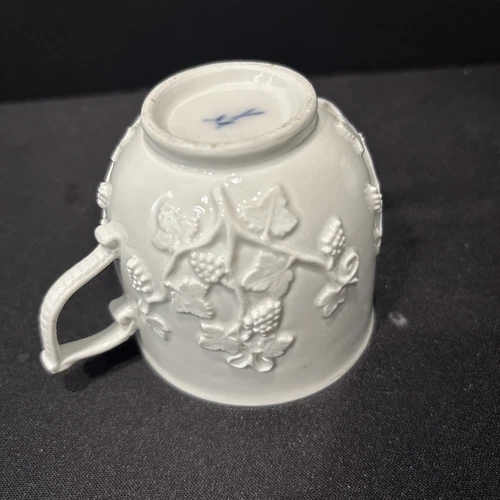梅森啊,梅森!
2025-8-22
下面这个梅森葡萄藤浮雕(Weinlaub)的杯子,原以为是1740-1750年代早期试验阶段生产的。


1740s–1750s → The first relief-moulded vine-leaf decoration appeared at Meissen, introduced under Johann Joachim K?ndler (chief modeller). Around 1774–1775 → The design was standardized into the “Weinlaub” service, with cups, saucers, plates, and pots decorated with grapevine reliefs, sometimes with green-painted leaves, sometimes left all-white (Blanc de Chine style, like yours). 19th century → The service continued in production, since it was very popular with aristocracy. By this point, it became one of Meissen’s “classic” patterns, still offered into the 20th century.
ChatGPT给出的年代,则是稍晚一点的1780-1795年代:

My conclusion: Your cup is most likely Meissen, vine-leaf relief, produced in the late 18th century (c. 1780–1795).
再贴一张更清晰的照片,ChatGPT给出了更肯定的意见:

1、Handle
Very thin, sharply edged, and slightly irregular in curvature.
The little thorn-like prongs on the top of the handle are classic late 18th century Meissen Rococo style (these disappear or get simplified in 19th century versions).
2、Relief Decoration
The grape leaves are deeply modelled, with crisp veins and sharp berry clusters.
This sharper relief is typical of earlier moulds (1770s–1790s). By 1800–1815, the reliefs soften, and leaves often look more “rounded.”
3、Body Shape
The cup has a slightly flared lip and a short footring.
This shape is also consistent with late 18th century Meissen teawares, right around 1780–1795.
而且,人家还给出来了反证:为什么不太可能是1740-1750年代的作品?
1740s-1750s 的浮雕白瓷通常属于试验式制作,装饰不够统一、把手造型也更传统,缺乏后来那种整体成熟感。
完整覆盖的葡萄藤浮雕:你的杯子在浮雕深度、造型线条与设计逻辑上显然成熟许多,它拥有深刻、锐利的浮雕,覆盖全器身,装饰层次丰富。符合1774–1790 年马尔科利尼时期的典型风格。
也就是说,它们更可能是属于 Weinlaub套装的正统期作品,而不是早期散碎的浮雕白瓷尝试。
